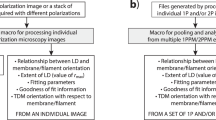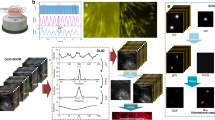Abstract
Membrane proteins are a large, diverse group of proteins, serving a multitude of cellular functions. They are difficult to study because of their requirement of a lipid membrane for function. Here we show that two-photon polarization microscopy can take advantage of the cell membrane requirement to yield insights into membrane protein structure and function, in living cells and organisms. The technique allows sensitive imaging of G-protein activation, changes in intracellular calcium concentration and other processes, and is not limited to membrane proteins. Conveniently, many suitable probes for two-photon polarization microscopy already exist.
This is a preview of subscription content, access via your institution
Access options
Subscribe to this journal
Receive 12 print issues and online access
$259.00 per year
only $21.58 per issue
Buy this article
- Purchase on Springer Link
- Instant access to full article PDF
Prices may be subject to local taxes which are calculated during checkout





Similar content being viewed by others
References
Day, R.N. & Schaufele, F. Fluorescent protein tools for studying protein dynamics in living cells: a review. J. Biomed. Opt. 13, 031202 (2008).
Shaner, N.C., Steinbach, P.A. & Tsien, R.Y. A guide to choosing fluorescent proteins. Nat. Methods 2, 905–909 (2005).
Piston, D.W. & Rizzo, M.A. FRET by fluorescence polarization microscopy. Methods Cell Biol. 85, 415–430 (2008).
Vrabioiu, A.M. & Mitchison, T.J. Structural insights into yeast septin organization from polarized fluorescence microscopy. Nature 443, 466–469 (2006).
Lakowicz, J.R. Principles of Fluorescence Spectroscopy. 3rd edn. (Springer, New York, 2006).
Shi, X. et al. Anomalous negative fluorescence anisotropy in yellow fluorescent protein (YFP 10C): quantitative analysis of FRET in YFP dimers. Biochemistry 46, 14403–14417 (2007).
Callis, P.R. The theory of two-photon-induced fluorescence anisotropy. in Topics in Fluorescence Spectroscopy Vol. 5 (ed., Lakowicz, J.R.), 1–42 (Plenum Press, New York, 1997).
Chen, S.Y. & Van Der Meer, B.W. Theory of two-photon induced anisotropy decay in membranes. Biophys. J. 64, 1567–1575 (1993).
Volkmer, A., Subramaniam, V., Birch, D.J. & Jovin, T.M. One- and two-photon excited fluorescence lifetimes and anisotropy decays of green fluorescent proteins. Biophys. J. 78, 1589–1598 (2000).
Benninger, R.K., Onfelt, B., Neil, M.A., Davis, D.M. & French, P.M. Fluorescence imaging of two-photon linear dichroism: cholesterol depletion disrupts molecular orientation in cell membranes. Biophys. J. 88, 609–622 (2005).
Axelrod, D. Carbocyanine dye orientation in red cell membrane studied by microscopic fluorescence polarization. Biophys. J. 26, 557–573 (1979).
Roorda, R.D., Hohl, T.M., Toledo-Crow, R. & Miesenbock, G. Video-rate nonlinear microscopy of neuronal membrane dynamics with genetically encoded probes. J. Neurophysiol. 92, 609–621 (2004).
Frank, M., Thumer, L., Lohse, M.J. & Bunemann, M. G Protein activation without subunit dissociation depends on a G{alpha}(i)-specific region. J. Biol. Chem. 280, 24584–24590 (2005).
Azpiazu, I. & Gautam, N. A fluorescence resonance energy transfer-based sensor indicates that receptor access to a G protein is unrestricted in a living mammalian cell. J. Biol. Chem. 279, 27709–27718 (2004).
Hein, P., Frank, M., Hoffmann, C., Lohse, M.J. & Bunemann, M. Dynamics of receptor/G protein coupling in living cells. EMBO J. 24, 4106–4114 (2005).
Bunemann, M., Frank, M. & Lohse, M.J. Gi protein activation in intact cells involves subunit rearrangement rather than dissociation. Proc. Natl. Acad. Sci. USA 100, 16077–16082 (2003).
Gibson, S.K. & Gilman, A.G. Giα and Gα subunits both define selectivity of G protein activation by α2-adrenergic receptors. Proc. Natl. Acad. Sci. USA 103, 212–217 (2006).
Leaney, J.L., Benians, A., Graves, F.M. & Tinker, A. A novel strategy to engineer functional fluorescent inhibitory G-protein alpha subunits. J. Biol. Chem. 277, 28803–28809 (2002).
Foerster, K. et al. Cardioprotection specific for the G protein Gi2 in chronic adrenergic signaling through β2-adrenoceptors. Proc. Natl. Acad. Sci. USA 100, 14475–14480 (2003).
Digby, G.J., Lober, R.M., Sethi, P.R. & Lambert, N.A. Some G protein heterotrimers physically dissociate in living cells. Proc. Natl. Acad. Sci. USA 103, 17789–17794 (2006).
Kroll, S.D. et al. The Q205LGo-alpha subunit expressed in NIH-3T3 cells induces transformation. J. Biol. Chem. 267, 23183–23188 (1992).
Hendel, T. et al. Fluorescence changes of genetic calcium indicators and OGB-1 correlated with neural activity and calcium in vivo and in vitro. J. Neurosci. 28, 7399–7411 (2008).
Miyawaki, A. et al. Fluorescent indicators for Ca2+ based on green fluorescent proteins and calmodulin. Nature 388, 882–887 (1997).
Mank, M. et al. A genetically encoded calcium indicator for chronic in vivo two-photon imaging. Nat. Methods 5, 805–811 (2008).
Palmer, A.E. et al. Ca2+ indicators based on computationally redesigned calmodulin-peptide pairs. Chem. Biol. 13, 521–530 (2006).
Cardona, A., Hartenstein, V. & Romero, R. Early embryogenesis of planaria: a cryptic larva feeding on maternal resources. Dev. Genes Evol. 216, 667–681 (2006).
Grynkiewicz, G., Poenie, M. & Tsien, R.Y. A new generation of Ca2+ indicators with greatly improved fluorescence properties. J. Biol. Chem. 260, 3440–3450 (1985).
Acknowledgements
We thank L. Nedbal, Z. Benedikty, R. Uhl, M. Buenemann, Z. Peterlin and J. Leps for discussions; C. Seebacher and A. Reshak for assistance with imaging; T. Bergmann, K. Tosnerova and members of the Institute of Physical Biology cell culture facility for technical assistance; R. Axel for inspiration; and G. Miesenboeck (Oxford University), M. Buenemann (Philipps University Marburg), A. Tinker (University College London), R. Tsien (University of California, San Diego), M. Asahina-Jindrova (Institute of Parasitology, Academy of Sciences of the Czech Republic), C. Berlot (Geisinger Clinic), J. Blahos (Institute of Molecular Genetics, Academy of Sciences of the Czech Republic), K. Deisseroth (Stanford University), S. Engelhardt (Technical University Munich), N. Gautam (Washington University in St. Louis), A. Gilman (University of Texas, Dallas), S. Ikeda (US National Institute on Alcohol Abuse and Alcoholism), M. Jindra (Institute of Entomology, Academy of Sciences of the Czech Republic), T. Knopfel (RIKEN Brain Science Institute), Y. Kubo (National Institute for Physiological Sciences, Japan), J. Ludwig (University of South Bohemia), R. Miller (Northwestern University), M. Rasenick (University of Illinois at Chicago), T. Montgomery, H. Sitte and T. Steinkellner (Medical University of Vienna) and M. Wildwater (Utrecht University) for constructs, cells and animals. The research was supported by the European Commission (FP7 Marie Curie International Reintegration grant PIRG-GA-2007-209789 'MemSensors' (J.L.), FP6-2005-Health project LSHG-CT-2007-037897 'Autoscreen' (J.L.)), Columbia University Science Fellowship to J.L., McKnight Innovation in Neuroscience Award (S.J.F. and J.L.), Czech government institutional grants MSM6007665808, MSM6007665801 and AVOZ60870520 (J.L.), EU Structural Funds grant CZ.1.07/2.3.00/09.0203 (J.L. and S.T.), University of South Bohemia fellowship (A.B.) and J.L.'s personal savings.
Author information
Authors and Affiliations
Contributions
J.L. conceived the idea, carried out mathematical modeling and analyses, performed initial microscopy experiments, developed image-processing software, directed the project and wrote the manuscript. A.B. performed microscopy experiments, prepared constructs, analyzed data and devised experimental strategies. S.T. developed software for quantitative analysis. S.J.F. contributed inspiration, consultations and funding.
Corresponding author
Ethics declarations
Competing interests
A patent #302233, covering the described method, device and applications, has been awarded by the Industrial Property Office of the Czech Republic (J.L.). A Patent Cooperation Treaty (PCT) application has been filed (J.L.). J.L. is a founder and owner of Innovative Bioimaging, L.L.C.
Supplementary information
Supplementary Text and Figures
Supplementary Figures 1–6, Supplementary Tables 1–3, Supplementary Note and Supplementary Discussion (PDF 5901 kb)
Supplementary Video 1
A three-dimensional reconstruction of a cell expressing dleGFP, imaged using two-photon polarization microscopy. A rotating view of the cell allowed visualization of LD of the whole cell surface. Color-coding and scale are the same as in Figure 2i. (MOV 695 kb)
Supplementary Video 2
Monitoring G-protein activation: GAP43-CFP-Gαi2. An HEK293 cell expressing GAP43-CFP-Gαi2, Gβ1, Gγ2 and α2a-adrenergic receptor–YFP, imaged by two-photon polarization microscopy (excitation at 800 nm, 0.20 f.p.s., shown at 10× speed), showing distinct LD. Upon exposure to an agonist (norepinephrine; presence indicated by an asterisk), LD disappeared, only to slowly reappear after agonist removal. Color-coding and scale are the same as in Figure 4a. (MOV 342 kb)
Supplementary Video 3
Monitoring G-protein activation: Gαo-Leu91-YFP. An HEK293 cell expressing Gαo-Leu91-YFP, Gβ1, Gγ2 and α2a-adrenergic receptor–CFP, imaged by two-photon polarization microscopy (excitation at 960 nm, 0.33 f.p.s., shown at 10× speed) shows LD. Upon exposure to an agonist (norepinephrine; presence indicated by an asterisk), LD disappeared, only to slowly reappear after agonist removal. Color-coding and scale are the same as in Figure 4c. (MOV 744 kb)
Supplementary Video 4
Monitoring calcium concentration using lynD3cpV. HEK293 cells expressing lynD3cpV, imaged by two-photon polarization microscopy (excitation at 960 nm, 0.33 f.p.s., shown at 10× speed), showed little LD in resting state. Exposure to ATP (presence indicated by an asterisk) caused an increase of LD. Removal of ATP led to gradual decrease of LD to initial levels. Color-coding and scale are the same as in Figure 5. (MOV 454 kb)
Rights and permissions
About this article
Cite this article
Lazar, J., Bondar, A., Timr, S. et al. Two-photon polarization microscopy reveals protein structure and function. Nat Methods 8, 684–690 (2011). https://doi.org/10.1038/nmeth.1643
Received:
Accepted:
Published:
Issue Date:
DOI: https://doi.org/10.1038/nmeth.1643
This article is cited by
-
Polarization modulation with optical lock-in detection reveals universal fluorescence anisotropy of subcellular structures in live cells
Light: Science & Applications (2022)
-
Quantitative linear dichroism imaging of molecular processes in living cells made simple by open software tools
Communications Biology (2021)
-
Super-resolution imaging of fluorescent dipoles via polarized structured illumination microscopy
Nature Communications (2019)
-
Fluorescence-detected linear dichroism imaging in a re-scan confocal microscope equipped with differential polarization attachment
European Biophysics Journal (2019)
-
Super-resolution dipole orientation mapping via polarization demodulation
Light: Science & Applications (2016)



